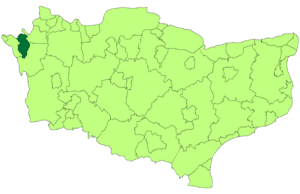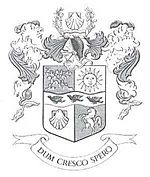Municipal Borough of Bromley facts for kids
| Bromley | |
| Motto: Dum Cresco Spero (While I grow I hope) | |
 Bromley Town Hall |
|
 Bromley within Kent in 1961 |
|
| Geography | |
| Status | Local board (1867 - 1894) Urban district (1894 - 1903) Municipal borough (after 1903) |
| 1871 area | 4,706 acres (19.04 km2) |
| 1911 area | 4,696 acres (19.00 km2) |
| 1961 area | 6,513 acres (26.36 km2) |
| HQ | Bromley Town Hall |
| History | |
| Created | 1867 |
| Abolished | 1965 |
| Succeeded by | London Borough of Bromley |
Quick facts for kids Demography |
|
|---|---|
| 1871 population - 1871 density |
10,764 2.3/acre |
| 1911 population - 1911 density |
27,397 5.8/acre |
| 1961 population - 1961 density |
68,252 10.5/acre |
 Coat of arms |
|
Bromley was once a special area in northwest Kent, England. From 1867 to 1965, it had its own local government. This area was like a suburb of London. It was part of the Metropolitan Police District, which meant London's police force covered it. From 1933, it was also part of the London Passenger Transport Board area, helping people travel around.
Contents
Bromley's History and Government Changes
Early Local Government: Boards and Districts
The Bromley Local Government District started in 1867. This happened when the local area, called a parish, decided to follow a law called the Local Government Act 1858. A group of twelve people, called a local board, was set up to manage the town.
Later, in 1894, a new law, the Local Government Act 1894, changed things. Bromley became the Bromley Urban District. An urban district council, with 16 members, took over from the old local board.
Becoming a Borough: A Royal Charter
In 1903, Bromley was given a special honour called a charter of incorporation. This meant it became a municipal borough, which is a more important type of town. The town celebrated this big event with a public holiday on September 2, 1903.
The charter arrived by train at Bromley South station. There, it was given to the first mayor of the new borough. The mayor then rode in a parade. Soldiers from the Royal Horse Artillery and the Royal West Kent Regiment led the way. Mayors from other towns in Kent and London also joined. About 20,000 people watched the parade. After the parade, a sports day and carnival took place at Queen's Mead.
With the new charter, a town council was formed. It included a mayor, six aldermen (experienced council members), and eighteen councillors. This new council replaced the old urban district council.
The council first met at the old Town Hall in the Market Square. But in 1907, they moved to a brand new Town Hall on Tweedy Road.
Boundary Changes and New Beginnings
Bromley's area grew in 1934. A new order added parts of the Bromley Rural District, including Hayes and part of Keston. Because of this, the council also got bigger, with seven aldermen and twenty-one councillors.
In 1965, the municipal borough of Bromley was officially ended. This happened because of the London Government Act 1963. Bromley's area became part of Greater London instead of Kent. Its former area joined with other nearby districts to create the London Borough of Bromley that we know today.
Bromley's Council and Politics
The council in Bromley was first run by independent members. These were people who didn't belong to a major political party. A small group of Labour Party councillors formed the main opposition. For a short time, from 1945 to 1947, there was even one Communist councillor.
The Conservative Party started to take part in elections in 1947. By 1950, they had won most of the seats. In the very last election before Bromley's local government changed, the Conservatives lost their overall majority. They had 14 councillors and aldermen, while other groups had 6 independents, 4 Labour, and 4 Liberal members.
Bromley's Coat of Arms
Bromley was given its own special coat of arms on April 19, 1904. A coat of arms is like a unique symbol for a town or family.
The design had four main sections. It showed three flying ravens on a wavy silver stripe. This wavy stripe and the ravens stood for the River Ravensbourne. Two branches of broom plants were also shown, which was a clever way to hint at the name "Bromley." A bright sun represented an area called Sundridge. A scallop shell was included because the diocese of Rochester (a church area) once owned the land of Bromley. Finally, a white rearing horse was added, which is a symbol of Kent.
The Latin motto chosen by the council was Dum Cresco Spero. This means "While I grow I hope."

